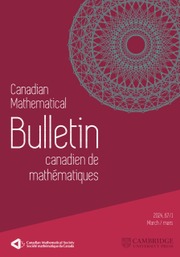Article contents
A generalization of immanants based on partition algebra characters
Published online by Cambridge University Press: 01 April 2024
Abstract
We introduce a generalization of immanants of matrices, using partition algebra characters in place of symmetric group characters. We prove that our immanant-like function on square matrices, which we refer to as the recombinant, agrees with the usual definition for immanants for the special case whereby the vacillating tableaux associated with the irreducible characters correspond, according to the Bratteli diagram for partition algebra representations, to the integer partition shapes for symmetric group characters. In contrast to previously studied variants and generalizations of immanants, as in Temperley–Lieb immanants and f-immanants, the sum that we use to define recombinants is indexed by a full set of partition diagrams, as opposed to permutations.
MSC classification
Information
- Type
- Article
- Information
- Copyright
- © The Author(s), 2024. Published by Cambridge University Press on behalf of Canadian Mathematical Society
References
- 1
- Cited by


